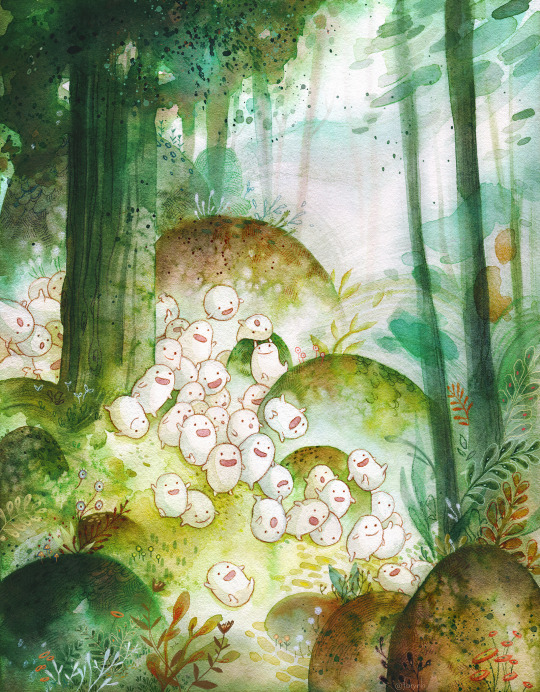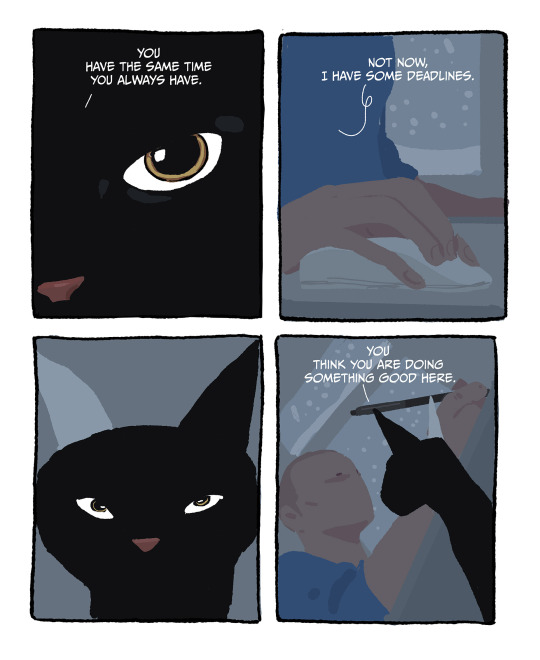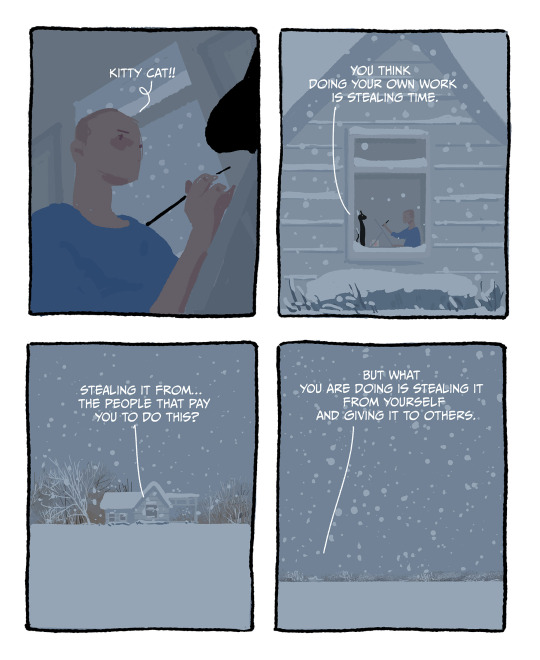Because that's my name. I write stuff, in addition to this blog.
Don't wanna be here? Send us removal request.
Text
I'm moving to Substack
So, pretty self-explanatory. Any future ramblings will be on Substack and Tumblr for now, but eventually I may stop bothering with Tumblr altogether. I'd appreciate it if anyone crazy enough to actually follow me here would also sub or follow or whatever it is people do over there. Here's my link: https://substack.com/@ryanmeft?utm_source=user-menu
0 notes
Text
Retrochievements: New Super Mario Bros. U

In my spare time, I like to create lists of achievements for games (mostly Nintendo games) that don't have them. I thought, since I'm not reviewing movies currently, I would start posting those lists here. Note that these includes the Deluxe additions but not Super Luigi U. Since Nintendo also released that separately, I am eventually going to give it its own list. And now, away we go.
A Good Walk (10)
Complete Acorn Plains
There’s No Cake Here! (10)
Complete Layer-Cake Desert
F.L.U.D.D. (10)
Complete Sparkling Waters
Ice To See You (10)
Complete Frosted Glacier
Pop Top (20)
Complete Soda Jungle
Big Rock Candy Mountain (20)
Complete Rock-Candy Mines
A Dollop Of Fluff (20)
Complete Meringue Clouds

Stomped Again (50)
Defeat Bowser

Plain Awesome (25)
Find every Star Coin in Acorn Plains
Cake For Breakfast (25)
Find every Star Coin in Layer-Cake Desert
Sunken Treasure (25)
Find every Star Coin in Sparkling Waters
Cold As Ice (25)
Find every Star Coin in Frosted Glacier
And A Bottle Of Pop (25)
Find every Star Coin in Soda Jungle
Digging Them Holes (25)
Find every Star Coin in Rock-Candy Mines
High Rewards (25)
Find every Star Coin in Meringue Clouds
The Queen’s Treasure (25)
Find every Star Coin in Peach’s Castle
Baby You’re A Star (10)
Complete one Star Road course
The Five Points (30)
Complete all Star Road courses
Got ‘Em All (10)
Complete every course in a world with optional courses
Hail The Conquering Heroes (50)
Complete every course in the game
Didn’t Need It (10)
Complete every course in the game without using a Super Guide
Victory Lap (20)
Defeat Bowser using every character
Nabbit’s Hideout (20)
Find the Purple Toad House
Super Duper Mario (10)
Complete 20 courses as Mario

Mr. L Strikes Again (10)
Complete 20 courses as Luigi
Mushroom Marauder (10)
Complete 20 courses as Toad
The Toad Toad Bop (10)
Defeat 100 Goombas as Toad
Chitter Chatter (20)
Shatter 100 frozen enemies

Shelled Shells (25)
Defeat 10 Bullet Bills with Koopa Shells
Cold Lead (25)
Have 50 Bullet Bills smash other frozen Bullet Bills
Sliding Smash (20)
Defeat 100 enemies by throwing frozen enemies at them
Turtle Soup (20)
Defeat a boss with fireballs
Don’t Mind Me (20)
Defeat 100 enemies with invincibility
By A Thread (20)
Defeat a boss without any power-ups

Bubble Battle (30)
Turn 100 enemies into 1-Up mushrooms
A Short Break And A Snack (20)
Eat 100 enemies
A Good Run (10)
Complete a course without taking a hit
World Warrior (30)
Complete every course in a world without getting hit
Power Plumber (75)
Complete every course in the game without getting hit
Millionaire (10)
Have 1,000,000 points

The 1% (20)
Have 5,000,000 points
Aces (5)
Gain two items in one visit to a Toad House
Extra Man Smorgasbord (10)
Gain 100 extra lives from 1-Up Houses
Enough For Everybody (25)
Gain a total of 300 1-Ups
The Classic (10)
Collect 100 coins in courses
Gacha! (10)
Catch Nabbit
I Can’t Escape From You (25)
Catch Nabbit ten times
Drop Your Guards (20)
Win 20 encounters on the world map
Y Tho (20)
Complete three ice-free courses wearing the Penguin Suit
DLC (Deluxe additions)
Breezy Melody (20)
Complete any course as Toadette
A Walk In The World (40)
Complete any world as Toadette
Easy Money (50)
Collect 500 coins as Toadette
With Grace To Boot (60)
Beat a boss with Toadette using the Peachette power-up
Moony Maiden (30)
Find 20 3-Up Moons as Toadette
That Was Easy (10)
Complete any course as Nabbit
Seriously Tho? (10)
Complete any world as Nabbit
Like I Need That (30)
Grab 100 power ups as Nabbit
Knocked And Nabbed (30)
Defeat all of the bosses as Nabbit
Oblivious (30)
Wander past 100 enemies as Nabbit
0 notes
Text
Kingdom of the Planet of the Apes Movie Review

The fourth (of the new) Apes movies has things to say about power, trust and race. That’s nothing new: 9 out of 10 big studio movies try to throw in some sort of message about life. The difference here is that Kingdom of the Planet of the Apes does so with some craft and subtlety, so that we never feel we’re hit over the head with a particular statement. The things the characters do can be taken metaphorically, yes, but they are also functions of who they happen to be. They do things because they want or need to do them; how we interpret those things is somewhat up to us.
Noa with no H (Owen Teague) is the son of the chief of the Eagle Clan, a band of apes who raid eagle nests and raise the chicks as their own. In a thrilling opening sequence, he, along with best friend Anaya (Travis Jeffery) and love interest Soona (Lydia Peckham), climb precarious plateaus to high nests, and of course something goes wrong, re-establishing the tendency of the newer Apes movies towards literal high-stakes action. In some regards, what follows adheres to precedents set by the previous films. A feral human (Freya Allan) invades the Eagle Clan’s village looking for food, and on her escape accidentally destroys the egg Noa had collected. He sets out to replace it, alone, which goes about as well as expected: by the time Noa returns to his village, it is on fire, burned on the orders of Proximus (Kevin Durand). That would be a gorilla with designs on kingship who rules an empire made of wrecked and rusting ships.

There are secrets to be revealed, and callbacks to the previous films. In the realm of the latter, Caesar’s teachings have formed the basis of a Moses-like tradition among the Apes. Raka (Peter Macon), an orangutan who caries a medallion* marking him as an acolyte of Caesar’s true principles of peace between man and ape, befriends Noa on his quest to stop Proximus. Raka saves books and befriends humans. Proximus has other ideas: his concept of “apes together strong” means apes must dominate humans, and that all apes must serve him.
It is key to this character that he does not think he is twisting the truth or conning anyone---he really believes that his way is right. His goal is to get into a locked vault from the days of humanity’s dominance, the contents of which are a mystery. He believes what is inside will fuel ape evolution. He is backed up by a human accomplice (William H. Macy), who reads him Kurt Vonnegut and Roman History. He is in a long tradition of villainous leaders who believe themselves elevated because they indulge in superficial cultural activities. Macy is his obsequious pet, an obvious-but-effective metaphor.

What makes a series like this not only work, but work across three directors? Wes Ball is the latest, and while his vision sort of melds with that of previous helmsman Matt Reeves, that is no bad thing. After three excellent previous entries, it is wise sometimes to stick to what works, and Ball and writer Josh Friedman choose to add new tweaks here and there to plotting and character rather than reinvent any wheels. The result will resonate with existing fans while providing a good inroad for new viewers, though the former will get the most out of it. It continues taking what was originally a fun-but-schlocky B-science fiction series and evolving it into something more.
Verdict: Highly Recommended
Note: I don’t use star ratings. Here are my possible verdicts:
Must-See
Highly Recommended
Recommended
Average
Not Recommended
Avoid Like the Plague
*bonus points if you recognize the design of the medallion
1 note
·
View note
Text
Movie Review: The Boy and the Heron

12 year old Mahito watches as bombs fall on Tokyo in 1943, and the hospital housing his mother is incinerated. He and his father promptly relocate to the countryside, where he marries his late wife’s sister and runs a munitions factory, but Mahito has little interest in these things. He is not disrespectful. He simply wants to be by himself. During one of his wanderings in the grounds, he spots a mysteriously behaved gray heron who leads him to a ruined tower hidden in an out-of-the-way corner. There his aunt eventually disappears, and though he doesn’t liker her that much, his father does. So he, the dutiful son, must find and rescue her.

Many of the films of traditional animation master Hayao Miyazaki start this way, with a disillusioned and lonely child discovering something magical. Few, even among his storied filmography, lead us on a journey like this one. The tower was said to either have been built by his great grand-uncle or fallen to earth in a star, but either way, when Mahito follows the heron inside while looking for his missing aunt, he enters one of those worlds only Miyazaki can deliver.
By this point the heron has hinted at his true nature, via a nose and a pair of eyes peeking out from its long beak. The interior of the tower it leads Mahito to is a ruined staircase, but much like the abandoned amusement park in Spirited Away, there is more here than there appears. Here I will stop describing the plot and begin feasting on some of the visual delights.
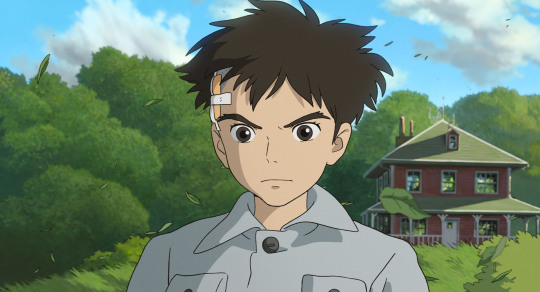
Within is a gate to a world somewhere between life and death. It is a water world where the sun seems never to fully rise or set, where gigantic fish prowl an underwater realm, and where even desolate swampland is beautiful to behold. It constantly surprises us. Mahito encounters a neolithic tomb behind a golden gate, a gaggle of white, joyful spirits that look a little like the video game character Kirby, throngs of hungry pelicans and multi-colored giant parakeets wielding forks and knives, and another tower that seems to exist in an ethereal reality, filled with randomly numbered doors that tantalize our curiosity.
To say Miyazaki, and his Studio Ghibli, are known for visual beauty is an understatement at this point. Multiple museums and coffee table books are dedicated to it. Yet in his latest the master and his crew top themselves, and deliver his most gorgeous film to date. Every frame is worthy of being isolated and studied as a piece of art. My favorite bits include those afore-mentioned Kirby Spirits ascending into the night sky and that giant tomb calling to something deep inside the viewer, but it’s so hard to pick and choose that I will have to watch the film a few more times so I can implant them all in my mind.

The movie does not only have visuals going for it. After a couple movies in which appearances trumped depth, Miyazaki made the more subtle The Wind Rises, about an airplane designer during the war. He has now returned to the glory days of Spirited Away and Princess Mononoke, with a film as moving as it is beautiful. I dare not reveal all the secrets of all the characters, but helping or hindering Mahito are a daring female sea captain, a mysterious woman with power over fire, a regal parakeet king who serves his people first, a mysterious man who harbors important information, and always that strange heron-man. They all factor into an emotional finale that leaves us holding back tears. This is a stunning achievement of both splendour and emotion, and the best film from Miyazaki in over 20 years.
Verdict: Must-See
Note: I don’t use star ratings. Here are my possible verdicts:
Must-See
Highly Recommended
Recommended
Average
Not Recommended
Avoid Like the Plague
12 notes
·
View notes
Text
Movie Review: Napoleon

Sofia Coppola’s Marie Antoinette married historical characters to contemporary pop music and behavior to present a Marie modern audiences could empathize with. The first scene in Ridley Scott’s Napoleon features her beheading, presented in gruesome spectacle in front of a bloodlust-filled crowd. It is indicative of the kind of movie Scott has made. Whereas Coppola was subtle, Scott will be extreme. It is, perhaps, the difference in a historical picture directed by a woman and one directed by a man. The important difference, though, is not gender but the fact that Scott does not pull it off. His touches of the modern day seem salacious rather than sympathetic, and his lead character never gets into our hearts.
Let us start by admitting that Joaquin Phoenix is one of the great actors of our time, and then let us further admit that he is miscast in this role. Scott and screenwriter David Scarpa, who also wrote for Scott another hidebound, powerful man in All The Money in the World, seem to want to focus on Bonaparte’s fraught relationship with his eventually-former Empress Josephine as much as, if not more than, his military victories. When battles begin, Phoenix is adequate. When he must court Josephine, or seem like a warm and loving husband, the script fails him and he fails the script. He finds some small strengths in Napoleon’s debaucheries. He is portrayed as a glutton and a poor-but-insistent lover, furiously humping an indifferent Josephine and indulging in food and drink on the premise that destiny meant him to enjoy the finer things. Outside of these moments his performance is cold and wooden.
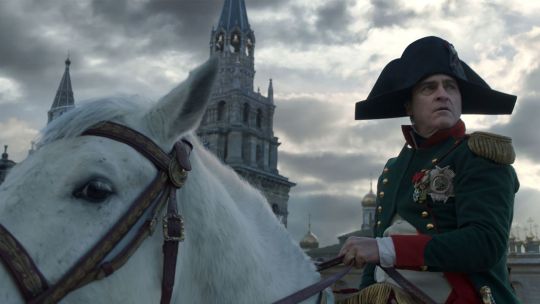
Saving the movie from a character perspective is Vanessa Kirby. She portrays Josephine as a woman with intelligence, cunning and passions she must fulfill. Like Kirsten Dunst’s Marie, she is a powerful female personality trapped by an era that has little to do with strong women, or indeed any woman. Look at Kirby’s eyes when Josephine is freshly released from prison and meets Napoleon, her hair slashed into a spiky pixie cut that menaces with its sharpness and her every word a bullet. She has been some places and seen some things, a fact she insists the general accept if they are to wed. Pulling a Basic Instinct, she shows Napoleon exactly what she has to offer under the hood, and it’s clear she holds all the power here.
Eventually she is exiled from the court because she cannot produce an heir. In her gilded confinement, Kirby summons notes of wistfulness and melancholy that were not required in Josephine’s days of power. Witness her reception of Napoleon’s son by his new wife. She goes from icy to maternal and Kirby’s face slowly catches up. She can handle anything Scott demands of her, and in a just world the planned four-hour director’s cut will focus mostly on expanding her character.

The battle scenes are unafraid to spill blood, and it’s here that Scott’s movie finally comes alive. Whether it’s Napoleon ordering his troops to fire on unarmed loyalists or his final stand at Waterloo, early 19th century warfare was chaotic, personal and gory, and Dariusz Wolski’s camerawork paired with incredible special affects, props and what looks like hundreds of extras recreate this to such detail that at several points I gulped nervously at the carnage on display. Unlike other aspects of the movie, it never feels like Scott has gone too far. We need to know this feeling. Portraying these battles as glorious and honorable would have been all wrong. A battle on a frozen lake is one of the great setpieces in modern film history.
Indeed, these battles lead to the film’s biggest question: what does the director think of his subject? He portrays him as a buffoon who lucked and needled his way into power, and at the end of the film he takes special care to highlight the sheer number of people who died in Napoleon’s military campaigns. It is clear he has an opinion, but he keeps it at arm’s length, contributing further to a film that is already chilly and impersonal. That director’s cut may fix some of the issues present, such as the rushed story in which it is hard to connect any one event to any other. It is instead a series of isolated episodes, moving forward suddenly years at a time, skipping straight from conversation to carnage, leaving us little to hold onto.
Verdict: Average
Note: I don’t use star ratings. Here are my possible verdicts:
Must-See
Highly Recommended
Recommended
Average
Not Recommended
Avoid Like the Plague
9 notes
·
View notes
Text
Movie Review: American Fiction
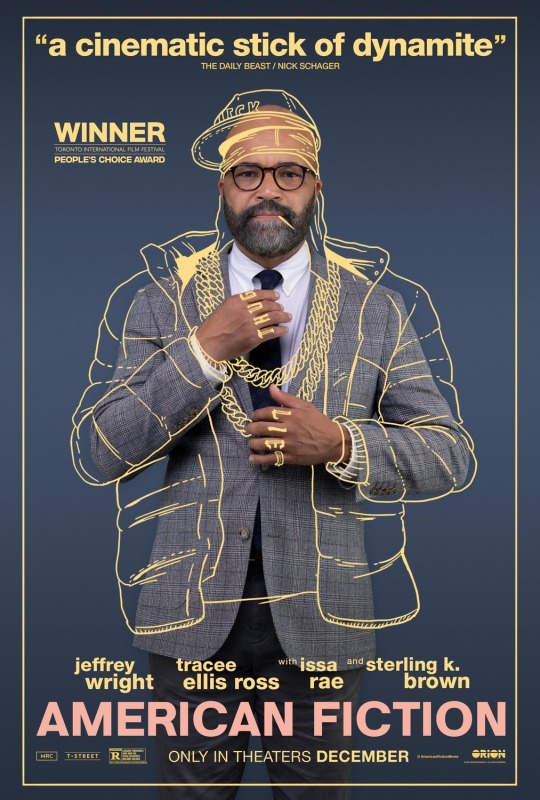
Thelonious Ellison is an angry man. You get the feeling that he is always angry, always has been angry and unless he changes something, always will be angry. He is right about the world and about people when he thinks that they all want easy answers and spoon-fed entertainment, but being right won’t fix what’s wrong with him. The movie is about whether he can do that himself.
What does he need to fix? Everyone around him has an opinion, and everyone may have a point. Understanding broken people requires broken people, so Monk, as he is usually called, is fortunate that his whole family is broken. They are still suffering from the suicide of the father, an unseen phantom. The mother (Leslie Uggams) is in the early stages of dementia. The plastic surgeon brother Cliff (Sterling K. Brown) has recently been divorced after being caught with a man, and has responded to his outing with unreserved debauchery. The only really responsible member of the family is the older sister Lisa (Tracee Ellis Ross), a doctor at a fictional version of Planned Parenthood, but when she unexpectedly dies, the family’s remaining broken pieces must come together to solve the puzzle that is them.

Monk does this while struggling with the low sales of his books as readers prefer more salacious fiction that gives them what they think the black experience is like---guns, drugs, hopeful stories of rising out of imagined ghettos painted in the most generalized of lights. Monk doesn’t want to tell that kind of story, and indeed argues that he cannot. He is a well-educated black professor from an upper-middle-class background, and he wants to write about the experiences of black people like himself. The audience doesn’t want to read them, and eventually in a night of doubt he gives in and dashes off a quick book that plays to the stereotypes, with Keith David and Okieriete Onaodowan as the hilarious personifications of two of his characters. Like the play in The Producers, he intends the book to be derided and to fail, and also like The Producers, it is an unexpected hit. Hurting for money, Monk and his long-suffering agent Arthur (John Ortiz) play along to increasingly hilarious results.
The most pressing issue on Monk’s mind is his mother, who deteriorates rapidly. Uggams’ performance is full of sympathy. She has a single screenplay-dramatic moment that ends up forcing the family’s hand, but mostly her condition is treated as a slow descent. Notes of The Father, one of the few successful depictions of Alzheimer’s on screen, can be detected here, as she becomes abrasive as a defense and only turns lucid long enough to recall her husband’s infidelity. Brown as the brother injects comedy into the proceedings with his many drug-loving younger lovers and his acid tongue, but it is to the film’s great credit that he doesn’t remain merely comedic relief. His story eventually gets a catharsis that allows Monk to think he might, at some point, receive his own. Monk’s only real ally seems to be newfound girlfriend Coraline (Erica Alexander), but there are cracks there from the beginning, as he covers up for his actual abrasive nature with the kind of humor that is meant to hide hostility.

Monk’s nemesis is Sintara Golden, a best-selling author who “writes black” in every way Monk disapproves of. Played by Issa Rae, she comes off initially as a cheap plot device, but shifts a little when the two are thrown into the same panel of judges for a book award contest. Yet another brave touch in the movie is how their inevitable confrontation is handled. We can at least sort of respect her as long as she thinks she is doing a genuine thing, even if she isn’t. Trapped in a candid moment, she lets down her practiced talk circuit defenses and reveals her true reasons for writing the way she does. What those are I will leave for you to discover, but the character is much stronger and a suitable nemesis for Monk by not being made into a “girl boss��� figurehead.
The movie is rife with conversations meant to expose the deep racial and personal biases well-meaning white liberals often inadvertently show. It is sometimes subtle and sometimes not, and for the most part each kind of depiction is effective. What strikes me most about this aspect of the movie is entirely subjective. I saw it in a preview screening at a film festival where the audience was mostly older and mostly white. Every time the film skewered some convention of “black” popular culture and the way non-black people see it, I couldn’t help wondering if I was the mark. If I was, I didn’t feel attacked by that, but rather encouraged to re-examine my views. The fact I did all this while laughing my ass off should at least tell you one thing: you should go see this movie.
Verdict: Highly Recommended
Note: I don’t use star ratings. Here are my possible verdicts:
Must-See
Highly Recommended
Recommended
Average
Not Recommended
Avoid Like the Plague
2 notes
·
View notes
Text
Ryan's 2023 Film Guide
For the hell of it, I've decided to slap together a "guide" for the 2023 movies I've seen, and whether and how much they are worth your time. I do not consider my opinion sacred or objectively correct, but hopefully what I have to write will help you make viewing decisions in some way. I'll post an updated version of this after I've seen more movies, but for now, here you go.
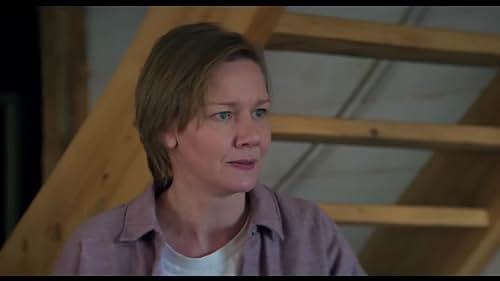
Anatomy of a Fall ***
Two incredible performances, by actors playing a mother and a visually-impaired son, elevate this courtroom drama/mystery even at times when one-note supporting characters and a somewhat indulgent running time threaten to upend our tolerance. In French and English with English subtitles.
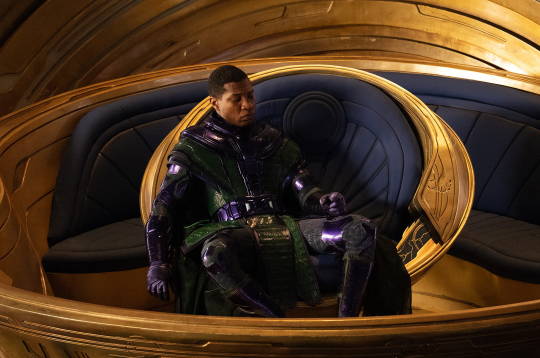
Ant-Man and the Wasp: Quantumania ***
Though it constantly tries to upend itself with with dumb humor and overproduction, this is a perfectly fine Ant-Man film for fans of the first two. It embraces comic book weirdness in a way fans disappointed in the franchise’s more sterile entries may appreciate.
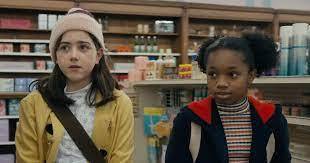
Are You There, God? It’s Me, Margaret ***1/2
I do love this modern trend in teen movies, where we shift away from gross-out sex comedies and into films that treat teens like budding adults, with all the baggage, hopes and fears that go with that. Whether you ever read the book or not, this is a coming-of-age story well worth a watch.

Asteroid City ****
I divided sharply with critics on Wes Anderson’s pretty-but-plodding previous feature, The French Dispatch, so it was a joy to see him return to the level of oddballs-and-misfits comedic genius he previously achieved in movies like The Grand Budapest Hotel. Every character is lovable and quirky in all the right ways, and the visuals are like a decorated cake you want never to eat, to avoid disrupting it.
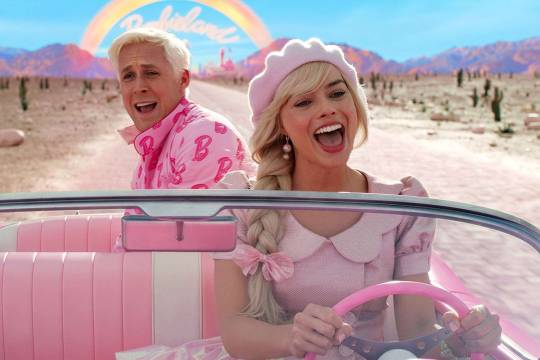
Barbie ***1/2
Margot Robbie, Ryan Gosling and Kate Mckinnon hit every single note that Greta Gerwig can concoct perfectly, delivering a movie that is funny, touching, poignant, and most definitely transcends the reputation of toy-based films. This is much more than a girl trip movie for the Sunday brunch crowd.

Creed III ***
If you liked the first two helpings of Creed, you’ll be well-served by this third dish. It moves Adonis forward in his own story, particularly outside the ring, and features a compelling new antagonist who challenges the hero in both arenas.

The Equalizer 3 *
With a single star entirely for the unfailing talent of Denzel Washington, the third Equalizer movie is otherwise a joyless, thrill-less, pointless morass of gruesome violence, hollow characters and plodding direction. You’ll feel unclean by the time it’s over, and eager to escape into the sunshine.

The Flash ***
Who would have thought a disregarded film in a dead-franchise-walking like the DCEU could be this much fun? Excellent action sequences, clever fan-service and a perfect odd couple dynamic (where the couple is actually two of the same person) add up to one of DC’s best movies, and a thrill for fans of bombastic old comics.
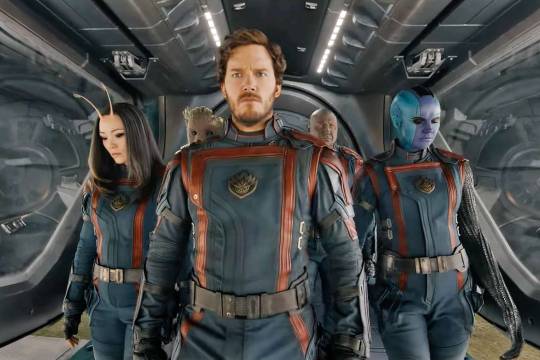
Guardians of the Galaxy Vol. 3 ***1/2
James Gunn and his crew send the Guardians off in style with one of the best superhero movies ever made, eschewing endless MCU connectivity bullcrap in favor of a character-driven sci-fi film that brings everyone full circle and delivers emotional closures for each character.

A Haunting in Venice ***1/2
The best yet in Kenneth Branagh’s series of Agatha Christie adaptations, a spooky setting, compelling mystery and excellent visuals are finally met by equally excellent performances of characters we find compelling, the key element that was missing in the previous films.
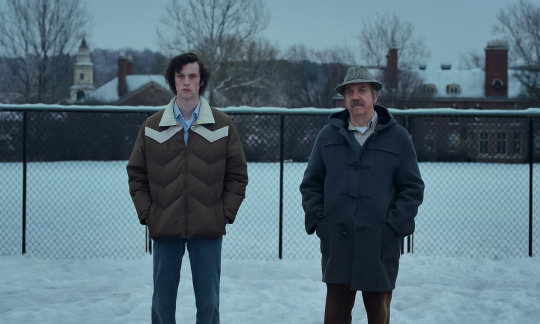
The Holdovers ****
At turns funny, endearing, touching and devastating, loneliness and the need for intimacy are explored through the lens of three dysfunctional people in one of the year’s best films. The environments, music, camerawork and literally everything else go a long way to redeeming Alexander Payne after the disastrous Downsizing.
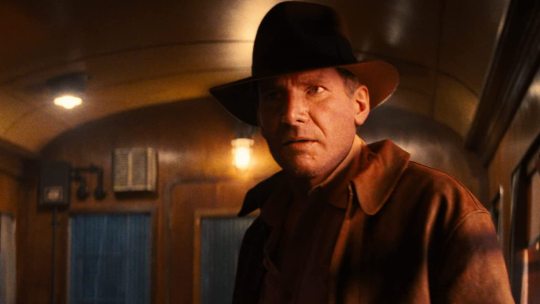
Indiana Jones and the Dial of Destiny ***1/2
After many (though not I) were disappointed with Kingdom of the Crystal Skull, Indy gets one more chance at a swan song through the magic of digital technology. While some may object to that on principle and a few action scenes carry on too long, the overall package is still Indy at heart, and the big closing sequence may be the series’ best, sending Indy out on an appropriate note.
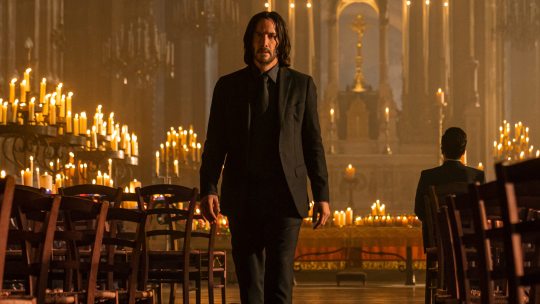
John Wick Chapter 4 ***1/2
Like Mission: Impossible, John Wick gets a nearly three hour runtime. Unlike Mission: Impossible, it earns that time with few reservations. The third movie kind of spun its wheels a bit, which is why it’s such a pleasure to say this one feels much shorter than it is and gives John a send-off both epic and personal.

Killers of the Flower Moon ***
A little too long, a little too sedate, and a little too obsessed with the villains at the expense of the actual Osage characters, Martin Scorsese’s latest passion project is nonetheless a true work of cinema for those with the patience to stick it out. You’ll be rewarded by stunning DiCaprio and De Niro performances, fantastic camerawork that drinks in every detail of the reservation, and a sobering message about the nature of evil and the too-often scant punishment for practicing it.
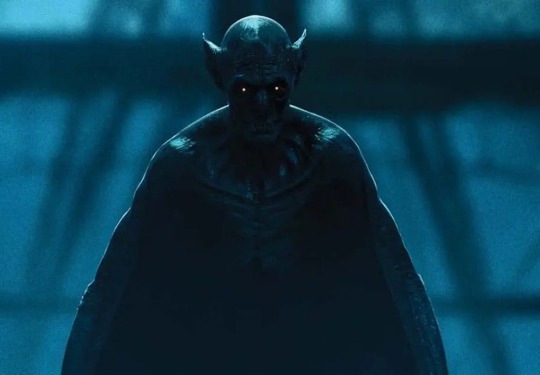
The Last Voyage of the Demeter ***
Billed as a closer look at what happened just before the events of the novel Dracula, this overlooked horror-thriller has a lot to offer anyone who feels that reasonably scary adventure movies should be more prevalent at theatres. There’s nothing revelatory here, but there is a fun and tense time if you’re into that sort of thing.

The Marvels **
This is the nadir of the MCU, a movie mostly so dull it could put food to sleep. The saving grace is Iman Vellani, who reprises her star-making role from the TV series Ms. Marvel and steals every scene she so much as breathes in. That’s also the movie’s biggest misstep: with five or six movies and TV shows being necessary viewing before going in, most people just won’t have the patience to slog through the homework for a mediocre film.

Mission: Impossible-Dead Reckoning Part One ***
You wanted action, you got action. With the exception of a few meaningless character-building scenes, the seventh M:I film barrels out of the gate and never slows down for the entire three-hour running time. That’s right: three hours. And if you think that’s a little long for M:I movie, you’re right. The audience will likely run out of steam long before the movie does, but if you’ve got the patience and a taste for pure action, you should still tune in.
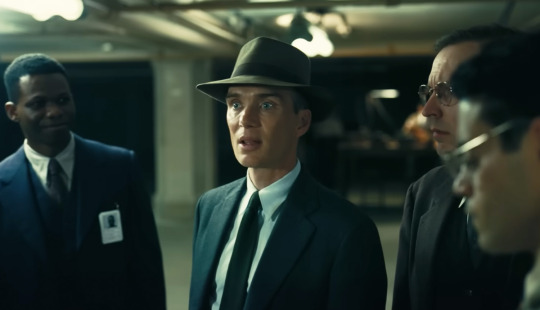
Oppenheimer ****
An incredible examination of power, progress and the dangers of intertwining the two, Murphy, Downey and Pugh all offer A-list performances in arguably Christopher Nolan’s finest film to date. It is as much about how weak men fear and revile excellence as it is about a bomb or a bomb-maker, and every element clicks to deliver these messages perfectly.
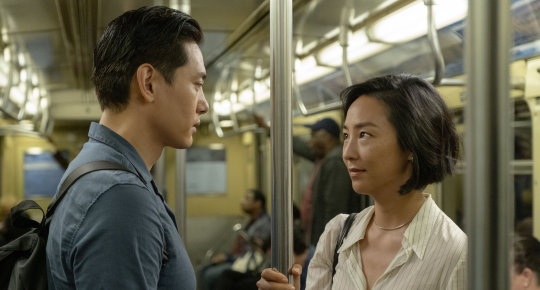
Past Lives ****
An intimate, character-driven look at how the road not taken affects our lives, Past Lives gets into your very bones and stays there. You may end up wondering where those old flames and friends have gotten to. In Korean with English subtitles.
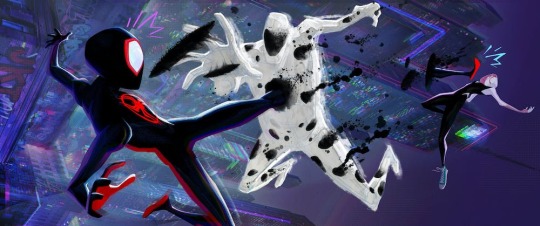
Spider-Man: Across the Spider-Verse ****
Packed with genuine thrills, revelations, twists and heart, the second in planned series of three Spider-Verse movies starts off strong out of the gate and doesn’t slow down. The development of the characters is spot on and subtle, especially for American animation, and the action and visuals are still executed perfectly. It’s the kind of thing we really want to see from a comic book movie.

The Super Mario Bros Movie ***1/2
It may not be what the critics wanted, but Mario is everything it needs to be for fans: witty, exciting, colorful and full of sly references to video game both famous and obscure. A musical sequence by Jack Black’s Bowser and a nihilistic magical star are among the touches that make it worthy of the attention even of families who do not game together.

Teeneage Mutant Ninja Turtles: Mutant Mayhem **
It’s got the cool animation style, it’s got the attitude, and it’s got the copious fan service, but unlike in Super Mario, these elements never cohese into a satisfying whole. The Turtles themselves are enjoyable enough in a movie that tries to ape Spider-Verse, but is held back by an outdated reliance on gross-out humor and lackluster plot.
#movies#disney#indiana jones#teenage mutant ninja turtles#horror#superheroes#martin scorsese#super mario bros#nintendo#killers of the flower moon#mission impossible#john wick#spider man#miles morales#marvel#comic books#oppenheimer#barbie#barbenheimer#the marvels#guardians of the galaxy#ant man#wes anderson
2 notes
·
View notes
Text
Assassin's Creed Locations Ranked Part 4
After a bit of a hiatus so I could work on my book and write movie reviews, we're back with part 4 of my list ranking every playable location in the Assassin's Creed series. As a refresher, a playable location is an area you can freely traverse and explore for secrets and missions, so places like Portugal in Rogue and the hidden tombs in II don't count. This entry covers some great historical and mythological locations that didn't quiiiiite make the top ten. We'll cover the top ten next time, so stay tuned to see which of those ten ended up where, and to get incredibly angry at me when your favorite isn't where you wanted it to be. Fun times! Here are the links to the previous three parts. Now, let's get moving. Part 3: https://ryanmeft.tumblr.com/post/731083916756336640/assassins-creed-locations-ranked-part-3
Part 2
Part 1
15
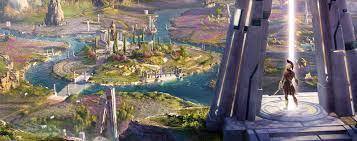
Atlantis (Odyssey: The Fate of Atlantis)
Odyssey’s Fate of Atlantis DLC had three chapters in three different places from Greek myth, but ever since our first tantalizing glimpse in a sidequest, visiting the fabled city itself was the big draw. It didn’t disappoint. Not only was the self-contained story pretty good, but Atlantis was successfully brought back closer to Plato’s description of concentric circles and military culture. There were both towering spires and underground secrets, and intrepid explorers could even carry themselves out from the artificial metro area to the more natural borders of the land. Atlantis promised a lot, and delivered on it.
14

Rome (Brotherhood)
A lot of people were probably kind of puzzled at the fact that, aside from a brief mission at the Vatican, we never visited Rome itself during Assassin’s Creed II. If you happen to also be my particular kind of crazy, you may know that the Renaissance was driven by the other cities in Italy, while any part of Rome not directly under church control had long since degenerated into a disease-ridden backwater virtually irrelevant to world progress. Brotherhood captures exactly that. This Rome is a dim shadow of the capitol of the ancient Empire, consisting almost entirely of wasted ruins of once-great temples, shabby houses, and pushy merchants hawking their wares. It’s not without some remnants of grandeur, but it evokes more sadness for a lost era than anything else. And naturally, the hidden tombs are still the highlights.
13
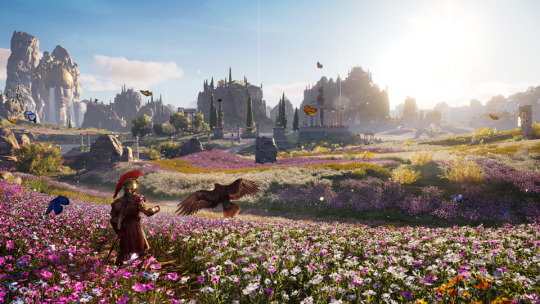
Elysium (Odyssey: The Fate of Atlantis)
The first of three areas you’ll visit in this episodic DLC, Elysium is, like Aaru, an idealized, paradisaical version of ancient Greece, with flowing fields of flowers uninterrupted by man and sparkling, wide rivers circling around the feet of towering clifftop cities where gods and accomplished mortals drink and feast in idyllic surroundings. Ok, I may be exaggerating that last bit, as the game doesn’t render the inhabitants of paradise in any real way---no Piece of Eden-induced apparitions of Hercules or Odysseus will be found here. Elysium so thoroughly evokes heavenly bliss, though, that it’s not hard to let your imagination fill in the blanks. In some ways, it’s even better than the normal Greece of the main game, because it’s contained enough that it never outstays its welcome.
12
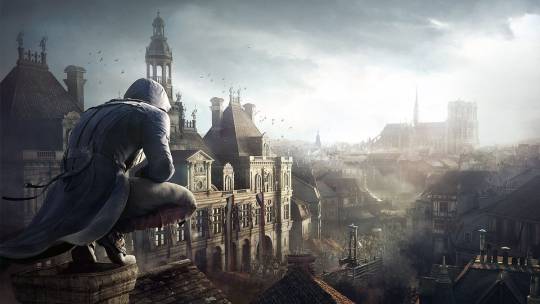
Paris (Unity)
Due to being borderline unplayable at launch, Unity remains a divisive entry in the series, but there’s one thing practically everyone can agree on: revolutionary Paris is jumpin’, man. Moving up a generation, Ubisoft Montreal took full advantage of the extra horsepower to massively increase crowd sizes and behaviors, the scope of the environment, and to render famous landmarks in exquisite detail. Paris is a place where the revered meets the depraved, from the towering spires of Notre Dame to seedy-but-lively cafes to grisly murders in dark alleys, all set to the backdrop of a violent revolution. The great accomplishment of Unity’s Paris is that the city is an ancient place with a life apart from the famous events of the late 18th century.
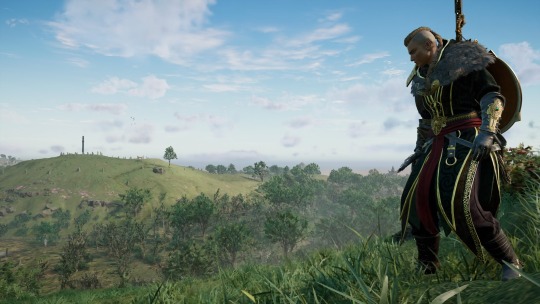
11
Ireland (Valhalla: Wrath of the Druids)
Much like how it is an extreme disappointment to see the fertile history of China’s Warring States Period relegated to a B-list mobile game, it was also a bit of a sting when we realized the only Ireland we were likely to get from the series was this DLC. Still, the Emerald Isle got a better shake than China likely will. Mechanically, there’s no differences in exploration or traversal, but the famously greener pastures, the shadowed, rocky paths that feature in so much Irish folklore, and the renowned passage tombs successfully make it feel like you’re in a new place. The story is even interesting, which is quite frankly more than you can say for most of the open world game DLCs. Still, if we never return to Erin for the more dramatic later periods in its history, it’ll be a shame.
And that's it for this entry! Come back next time to see which games shook out where in the top ten, and remember to please share my blogs if you like them.
1 note
·
View note
Text
Movie Review: The Holdovers
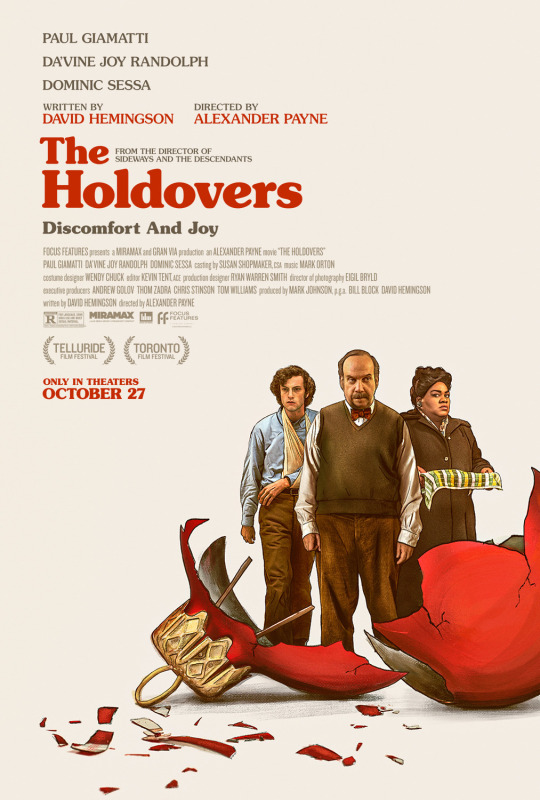
After the disaster of Downsizing, Alexander Payne has returned to what he does best: dysfunctional families. This time, they are not blood, but rather a misanthropic prep school teacher, his rebellious student, and the grieving mother who cooks the food. They are thrown together over the holidays when the student’s uncaring parents would rather vacation by themselves. The student is neglected, the professor is cantankerous, and the cook is barely holding it together. They each have their own stories, and we are never given every piece of any of them, which is how it should be. In life we never know everything about those around us, as much as we might think we do.
And indeed, the teacher, Paul Hunham (Paul Giamatti) has hidden layers that he is fine with no one knowing about. He is confronted early on about how standoffish he is, and he does not seem to be putting on a front at all when he says he does not care. He is expected to give students from wealthy families grades they didn’t earn so they can get into colleges they don’t deserve, a thing he will not do. Flunking one particular student winds up landing him the job of supervising the students who can’t go on winter break, and he is spectacularly unsuited to the task. He starts with five but ends up with one: Angus Tully.
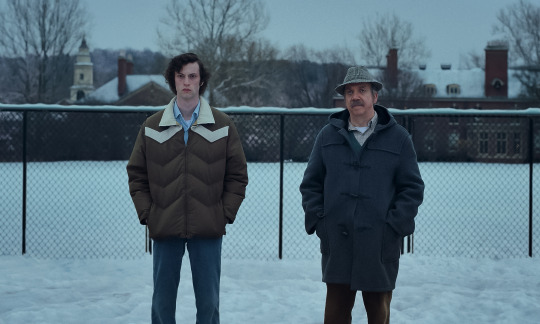
Tully is the brightest student in the class, which, given his teacher’s strict standards, nets him a B+ on his final. He’s also by far the most rebellious, reacting as he is to a deceased father, an indifferent stepfather and a mother more concerned with her status than with him. He’s been kicked out of three schools, one more will mean a military academy, and his teacher has no problem telling him he doesn’t like him. I felt some of myself in the young man, and I know from experience that it is almost impossible not to rebel under such conditions. He is played with award-worthy precision by newcomer Dominic Sessa. Sessa knows the language, expressions and body movements of a High School student because he was a High School student when he was cast. A scene in which he leads Paul a merry chase throughout the school is vital, as Sessa has to shift from hostile to playful and back again several times in one sequence. This should be one of those rare times in which an unseasoned actor receives major award consideration.
This odd trio is rounded out by Mary Lamb (Da'Vine Joy Randolph), the school’s cook. She takes her job seriously, perhaps too much so, but she needs the outlet so that she does not spend all of her time grieving her 18-year-old son, recently killed in Vietnam. Randolph has more to do than simply moderate between the two extremes of conservative teacher and rebellious student. Her open grief, when it comes, is not a maudlin moment but a bit of emotional truth, as Payne and screenwriter David Hemingson recognize that pain often manifests itself quietly. She gets her one moment of abject misery, recovers quickly, and does what so many of us must: pours her hurt into a project, namely her sister’s imminent baby.
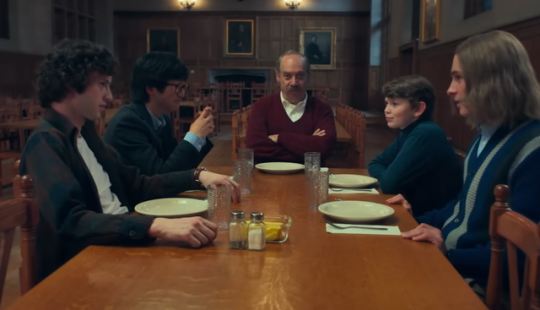
I devote an entire paragraph to each character because I would watch a movie entirely about any one of them. I very much wanted to know what bits of them Payne and Hemingson had to leave on the cutting room floor. Those bits may be hidden in their environment. When an impromptu “field trip” to Boston becomes a therapeutic excursion for all three, we see that Mary’s sister’s home, an apartment on the fourth floor of a decaying building layered with icy stairs, is a refuge to her. The small rooms and close conditions, things we might consider limitations, grant her and her family the intimacy she seeks, and we keep that contrast in mind as Paul and Angus explore a seedy Boston dotted with dive bars and porno shops, a place where daylight is timid and snow is always dirty.
The real environmental star of the show, though, is Baron Academy, played by Groton, Northfield Mount Herman, Deerfield, and St. Mark's, all real New England boarding schools. With most everyone gone for the season and snow all around, the place is both a warm refuge and a dim prison. This really depends on who you ask, as the teacher sees it as home, the cook as a job, and the student as purgatory. I want to watch the movie again so I can appreciate the way the characters interact with the empty halls and quiet gymnasium. It is a combination of the alluring Hawaiian landscapes of The Descendants and the flat rural no-man’s-lands of Nebraska, a place that meets both extremes in the middle. I wanted to take a walk around it myself, preferably with these eccentric oddballs as my tour guides.
Verdict: Must-See
Note: I don’t use star ratings. Here are my possible verdicts:
Must-See
Highly Recommended
Recommended
Average
Not Recommended
Avoid Like the Plague
1 note
·
View note
Text
Movie Review: The Marvels
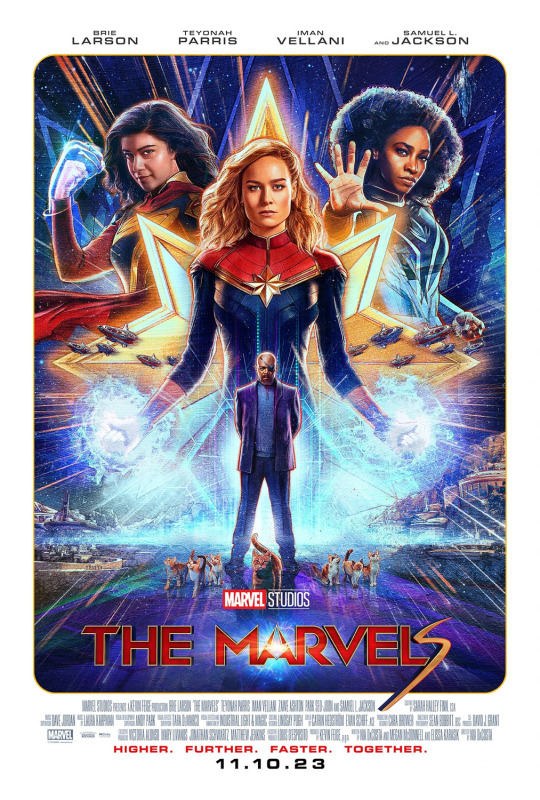
This is Ms. Marvel’s house, and everyone else is just a tenant. The latest MCU outing is the lowest point of the franchise to date, with a muddled and poorly-explained plot, two wooden leads, an underutilized villain, and entirely too much MCU advertising. At a brisk 105 minutes, it is somehow both overstuffed and rushed. So how, then, can I say you should see it? Two words: Kamala Khan.
It is thirty years after the original Captain Marvel. Carol Danvers (Brie Larson) lives on a spaceship and seems to hold down a job as a galactic peacekeeper-ambassador, though how this keeps food on the table is unclear. Nick Fury (Samuel L. Jackson), also residing in space but on a massive station, sends Monica Rambeau (Teyonah Parris) out on missions to investigate…something. This something, which looks kind of like the way movies always portray event horizons, is a strange disturbance in space that can A: cause wormholes, B: be used as a source of power for the villain and C: make it so that the movie’s three heroines swap places whenever they use their powers. It’s a cosmic maguffin working overtime.

This plot is, to be kind, a mess. The Space Something causes Danvers and Rambeau to swap places with each other and Kamala Khan (Iman Vellani), lead hero in the Disney+ show Ms. Marvel. As the characters swap powers, they shift between Kamala’s home, Danvers’ spaceship, Fury’s space-station and various other planets, including an intriguing one where everyone speaks in song. None of these feel like any more than pit-stops for the plot, and we constantly wish the film would pick one or two and focus on those. So, too, does Zawe Ashton’s villain get slighted. Superhero movies usually deal in uncomplicated maniacs, and Ashton’s Dar-Benn bucks that trend, with a legitimate reason to be pissed off at the hero. This reason is done away with in a flashback and never explored as a deeper part of the character. Like Thor: Love & Thunder, the movie could have benefited from slowing down and taking more time to establish its villain as a person.
Let’s leave aside the plot for a moment, though, and discuss the young woman named Kamala. For those who watched the show Ms. Marvel, no introduction is necessary. For those who didn’t, she’s a teenager in Jersey City who inherits light-bending properties from a time-traveling gauntlet inherited from her grandmother. Her powers are less important than her personality, for she ends up being the glue that barely holds a confused and dull film together. Played by newcomer Iman Vellani, she has that Spider-Man energy, bringing an enthusiasm and seemingly effortless charm to every scene she steals.
She also happens to be a massive fan of Danvers, yet Vellani knows how to hold back and let her enthusiasm build rather than just running up and spouting a one-liner. Her expressions, body language and every line of dialogue are perfect for the character, which is good, because the film desperately needs her. Larson and Parris never manage to generate any individual sympathy from the audience, and spend all their non-Kamala time dryly reciting details of the impossible-to-follow plot or making bland promises of heroism. At one point, when CM must reduce herself to tears over having accidentally done a very bad thing, it’s obvious Larson is forcing the waterworks, and when Parris must confront a vision of her deceased mother (Lashana Lynch), her reactions are right out of summer stock.
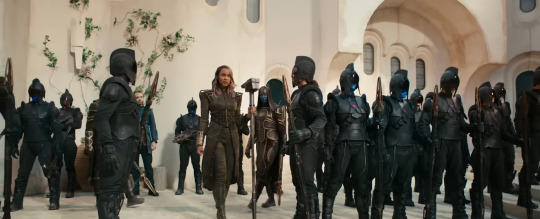
Vellani’s only credits so far are all playing Ms. Marvel, but if the universe loves us, she will be a star long after the MCU has finally crumbled to dust. She and Jackson are the only ones on screen who seem even dimly aware of how silly this all is, and they treat it all like a game. You can’t say the movie doesn’t have some clue what the audience wants, because in the best non-Kamala moment it multiplies the previous film’s mutant alien cat into dozens. I won’t tell you why the film needs these cats, but does it matter? An alien mutant kitten is its own reward. To get that reward, you need to have watched several TV shows and movies (I won’t say which ones, to avoid spoilers), and the film often feels like homework that most people forgot to do.
Once we’re done with the nonsense plot, the rolled-over-and-died dialogue, the emotionally hollow acting and constant pushy references to the larger MCU, we know only one thing: Ms. Marvel needs her own movie. She’s already left this one in the dust.
Verdict: Average
Note: I don’t use star ratings. Here are my possible verdicts:
Must-See
Highly Recommended
Recommended
Average
Not Recommended
Avoid Like the Plague
#movies#disney#the marvels#iman vellani#brie larson#samuel l jackson#teyonah parris#zawe ashton#superheroes#comic books
7 notes
·
View notes
Text
Killers of the Flower Moon Movie Review

It is a sad and quiet thing. In the early 1920s, the Osage Indians who live in Oklahoma are the richest people per capita on earth, because the worthless land they were forced onto is in fact bursting with oil. After centuries of persecution, they now drive the finest cars, eat the finest foods and live in the finest homes. And bit by bit, one by one, their fortunes are transmuted into white men’s fortunes. Rich Indians are dying mysteriously, and every death seems to benefit a white man.
The subtitle of the book by David Grann is “The Osage Murders and the Birth of the FBI”. These words make it clear that the two-fold focus of the story is on the victims of the killings and the attempts to crack the case. Indeed, in the book, the years-long investigation takes up most of the second half, while the first half is largely focused on the Osage themselves. Readers are given many plausible leads, and the identities of the perpetrators are left in doubt until the G-men begin to uncover them.

Scorsese takes a different approach. Within ten minutes of the 206-minute runtime, we know exactly who the villains are, exactly what goals they have, and swiftly after that we know their methods. Almost the entire film is consumed with studying them, while never offering a human motivation to their madness. That is not a deficiency of Scorsese and Eric Roth’s screenplay, but a simple consequence of the fact no sane motivation can exist for the atrocities committed by William Hale and Ernest Burkhart. Robert De Niro and Leonardo DiCaprio unite for the first time under one film to portray the master and his willing lieutenant. One has nothing human left in him, while the other trades what is left of his for money.
As with Spielberg’s fascination with Amon Goeth in Schindler’s List, Scorsese himself seems gobsmacked that such a blatantly evil man as Hale can exist. Dubbed “The King of the Osage Hills”, he is composed of so many self-justifying threads that the man ought to collapse under the sheer weight of his own contradictions. In strictest confidence, he informs Burkhart that the Osage money must remain “in the family”. When speaking of assassinating, brutalizing, poisoning and blowing up the people who stand in the way of the transfer of that wealth, he talks as if he were discussing the weather. While he does this, he offers high sums for the capture of the culprits and assures his Osage “friends” that their loved ones are in a better place. Money is his stated motivation, but his true motivation seems to be to do whatever he wants and get away with it.
No better actor could have been found for this role than De Niro. He is so natural a paternalistic figure that even I, who finished the book mere weeks before the film released, wanted to believe he was genuine. To believe he is masterminding dozens of murders of those who trust him out of pure lust for power is like being asked to accept that your own grandfather is guilty of war crimes. Scorsese examines his quarry from a great remove, never letting us inside his private thoughts or very deep into his inner character.
This is in line with the book, in which Hale’s own life is regarded from a distance. How else can you regard it? There is nothing that could change to make him sympathetic. He is an animal driven by covetousness, elevated above the thugs he employs only by his suits and his status. Indeed, he begins already wealthier than he ever needs to be. He does not not need the Osage money. He simply wants it.
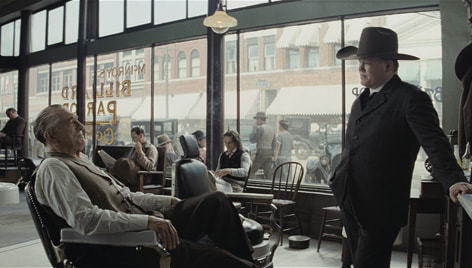
Ernest Burkhart, a naturally nervous and rough man, does need it, not being independently wealthy himself, and he goes from petty thief to a willing cog in a grander scheme, constructing ever more elaborate rationalizations. He reaches a point where he is willing to slowly poison his own wife and blow up innocent people’s homes with them inside, yet he never quite reaches Hale’s level of detestable evil, because his actions are directed by another. Burkhart is aided by a series of accomplices who play on the trust of the Indians, and while each stands out, it would be too laborious to summarize them all here. Instead DiCaprio assumes the role of the most visceral bad guy, taking many traits of the book’s characters unto himself.
As the plot progresses, it becomes less quiet but no less sad. Hale, finding his thefts less smooth and more challenged as outside forces intervene, resorts to increasingly brazen means to keep the wealth flowing from the Indians and to him, and finally he pulls the caper that gets him caught: the bombing of the home of Bill Smith (Jason Isbell) and his Osage wife Rita (JaNae Collins). This is too loud, and it sends Mollie to Washington to beg assistance from the President directly. That involves the Bureau of Investigation, precursor to the FBI, who dispatch Tom White (Jessie Plemmons) to the scene.
Here Scorsese’s choice results in the film’s biggest weakness. In the book, since we don’t know the details of the master plan from the outset, the investigation takes up a much larger portion, and it is a thrilling one. Witnesses come and go, being seduced or murdered by Hale, seedy private detectives hinder more than help, and the Osage Hills become a place where people disappear into the chaos of the early 20th century’s new frontier. These investigations in the film take up barely the space allotted to an episode of a TV procedural, and since the solution is a foregone conclusion, all of the tension is sapped.
Similar, too, is the treatment of the Osage characters. Grann develops them in detail, reaching into their inner worlds. Most importantly, he portrays their lives in the context of their times, where white men ostensibly charged with protecting them think less than nothing of turning Osage wealth into their wealth. A murder of an Osage, as the movie points out, is after all less of a crime than the murder of a dog, and the Osage are only wealthy because they lucked into land that should have belonged to whites.
While Lily Gladstone as Mollie Burkhart, whose husband slowly poisons her with tainted insulin, absorbs every scene she is in, she is ultimately in too few and Ernest in too many. Again Scorsese has chosen to focus on the villains, and we never get to know Mollie as a person. The politics of the times are likely to ensure Gladstone becomes the first Native actor with a real shot at an Academy Award, and she has earned it but done so in a role that should have been greater than it is.
It is not my job to turn in a book report but to tell you if this shift in scope damages the film. That answer may depend on your perspective. Scorsese wanted to make a film that regards a fundamental evil as a force unto itself, without justification, and he has made one. It will not grant great insight into any other aspect of the times, the people or the killings, but it does come with one great insight into American culture: the traditional text denouement of what happened to who after the film is replaced by putting on one of the radio plays J. Edgar Hoover so loved for the glorification of the Bureau and himself. Actors-playing-actors read out the fates of the cast while using common objects to create the sound effects, and viewers of a pre-TV era can appreciate this both on a stylistic level and for the look it gives us as to how we process reality.
Verdict: Recommended
Note: I don’t use star ratings. Here are my possible verdicts:
Must-See
Highly Recommended
Recommended
Average
Not Recommended
Avoid Like the Plague
Note: both the book and the film use the term Indian to refer to the Osage characters, and I have followed that convention here.
0 notes
Text
Assassin's Creed Locations Ranked, Part 3
After a long delay, here's the third part of my ranking of every location in the Assassin's Creed series. I have linked the first two entries below, and you can see my criteria by clicking on part 1.
Part 1
Part 2 https://ryanmeft.tumblr.com/post/729093968203218944/assassins-creed-locations-ranked-part-2 Let's get to it.
19
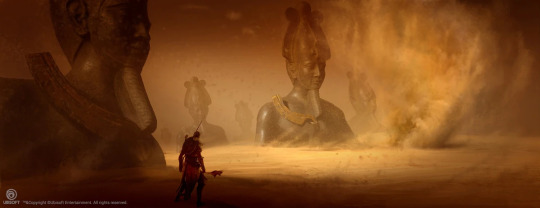
Heb Sed (Origins: Curse of the Pharaohs)
Don’t remember this one? I don’t blame you, but hold on, because it might be more interesting than you recall. Egyptians didn’t have a real concept of eternal torment---you either got into paradise or were devoured by an immortal chimera, which admittedly isn’t much better. Ramesses II was a Pharaoh whose reign was marked by his never-ending desire for conquest, and his illusory afterlife reflects this, being a sand-blasted waste littered with the remains of well-known Egyptian icons. It’s more interesting than it sounds. The fact his eternity is a blighted and ruined form of his own country, not anyone else’s is pretty psychologically interesting, and wandering these ruins is less overtly oppressive than the cauldron that is Hades, and more a sad affair as you search for an enemy so obsessed with war he has no peace even in death. It’s not beautiful, but it’s an interesting concept more original than Aten, and thus ranking higher.
18
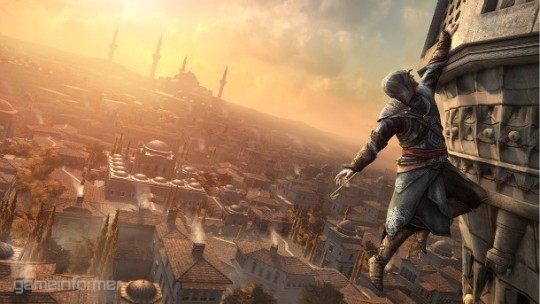
Constantinople/Istanbul (Revelations)
The legendary city that became the eastern Rome was mostly a barely-disguised reskin of Brotherhood’s setting, but the smoke of hookah, the Grand Bazaar full of colorful wares, the elaborate clothing and the heavy presence of books as a standout environmental and gameplay element helped give the city a mostly fresh feel. Whereas Brotherhood sacrificed story for gameplay, Revelations focused on the narrative and the environment a bit more heavily, resulting in the genuine feeling that you were in a place and time where the world was rapidly changing. It’s still a reskin, but it is a pretty good one.
17

North Atlantic (Rogue)
It’s pretty abundantly clear that Rogue was made to tap III and Black Flag’s immensely popular sailing gameplay one more time before moving on to the landlubbers of revolutionary France. Like Revelations, you can often practically see the Caribbean sea and the Colonial frontier underneath the forts and frozen oceans. Fortunately, though, this time the series did a little bit more than just reskin existing environments. The “River Valley”, so-named because the terrain is loosely based on the famous Hudson Valley, has more dips and swells in it than III’s frontier, while the frigid oceans and their neighboring cliffs successfully evoke history’s maritime chase for the fabled Northwest Passage. It’s still a reskin and therefore can’t rank higher than most original locations, but it’s a better reskin than that in Revelations.
16
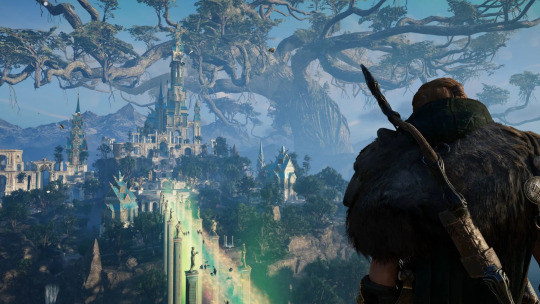
Asgard (Valhalla)
A lot of this was mentioned in the entry on Dawn of Ragnarok’s vastly inferior Svartálfaheimr, so I’ll keep this brief. Asgard is a place where the towering halls of the fabled city give way to deep, Isu-ruin-studded caverns, and Ratatosk and Fenrir freely roam amid recreated Norse stories. You can leave whenever you want, but it’s such a beautiful place to visit that you probably won’t go back to England until you’ve licked the plate clean. The only downside is that the connection to the Isu plotline is murky at best, which is either a strength or a weakness depending on how much you like the frame story.
That's it for this short entry. Come back next time to see entries 15-11, and then one more time to see what the top ten are and in what order.
2 notes
·
View notes
Text
Movie Review: A Haunting in Venice
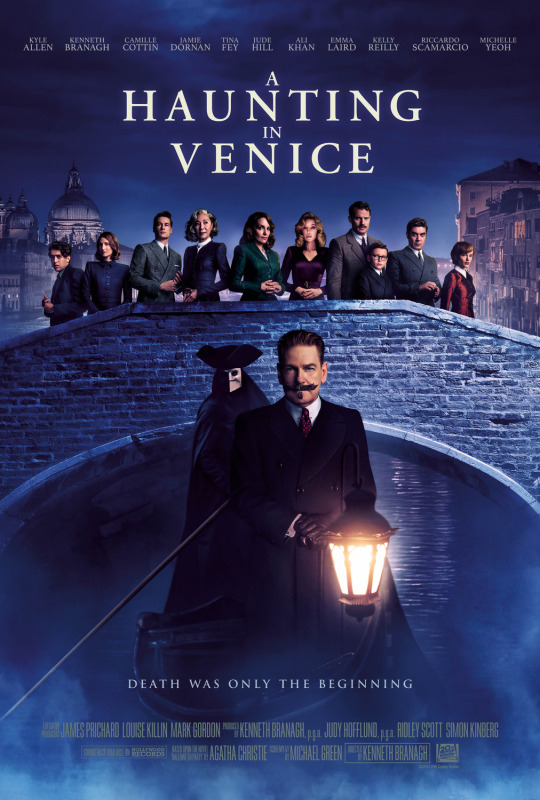
In every skeptic there is a glimmer of faith, and the stronger the skeptic the stronger the glimmer. A skeptic is simply someone who has looked at the world and discovered that it is not how they wish it were. It is not a comfortable or happy revelation, and most of us would happily abandon it were there the slightest hint of fact to any other explanation. That is the situation Hercule Poirot finds himself in at the beginning of A Haunting in Venice. He appears to enjoy a life of tea and retirement, but he is a broken man, thinking nothing of his bodyguard laying out a desperate man seeking his aid and acting as if humanity does not exist.
It is 1947, ten years since we last saw Poirot in Death on the Nile. The time has been intentionally chosen by director and star Kenneth Branagh, working from a late, poorly received entry in Agatha Christie’s novel series, which specifies no date. He has taken a free hand with the material and chosen his year so that the exuberant, confident, arrogant Poirot of DotN can be replaced by one whose faith in God, humanity and everything else has been wiped out by going through two World Wars.

The opening device of a retired detective wasting away without a case is hardly new, but Branagh sells it well by adding something new to the unflappable detective---flappability. Summoned by his old writer friend Ariadne (Tina Fey) to a seance by a medium (Michelle Yeoh) she professes to be unable to expose, he encounters the series’ usual lineup of eccentric oddballs: Rowena Drake (Kelly Reilly) the mother of a young woman who drowned the previous year, the deceased woman’s arrogant, fortune-seeking ex-fiancee (Kyle Allen), Olga (Camille Cottin), the extremely superstitious housekeeper, a doctor (Jamie Dornan) traumatized by the war and his son (Jude Hill), who is more interested in books than people, the medium’s opportunistic assistants (Emma Laird and Ali Khan) and Poirot’s own bodyguard (Riccardo Scamarcio).
Inevitably there is a murder and these people end up locked in with Poirot, this time in an old, rotting Venetian palazzo that is said to be cursed by the long-dead souls of children left there to die of plague. A train and a boat can have nothing on this place---it is an excellent accomplishment in the use of a great setting at a time when setting hardly matters in most wide release movies. Like any good, really old house, it is strewn with expensive treasures under dusty coverings that are stretched throughout hallways and rooms which are just narrow and close enough to be confining, but not so much that they don’t also look really neat. Always threatening the proceedings are Venice’s famous canals. All of this murder and suspicion takes place during a really cracking storm, and the waters reach menacing fingers toward the foundations of the building. We are, every so often, shown the window from which the dead woman fell, a spectre of a real, well, spectre. Most of this was done in Pinewood Studios, but many exteriors are clearly the sinking city, itself.
The previous movies were dependent on the (by now a bit tired) premise that the genius was always one step ahead, even when they do not appear to be. This one depends on taking that same character and shaking him badly, leaving him in genuine doubt, fear and panic. The best horror movies operate also on this principle. They place a disbelieving person in a situation where their disbelief will be tested, for it is so much more frightening encountering a scary thing you didn’t think existed than one you fully expected. Poirot faces new types of challenges this time, something that couldn’t quite be said for DotN. He hears voices. He seems to be ill. Every mystery he figures out simply crumbles into a new one. There is an attempt on his own life. And there is always that storm. He handles this by hiding frequently in the restroom so as not to let his panic be seen, but we see it, and his struggles with his own skeptical nature humanize the character in a way not previously accomplished. For all his affected, fabulous-moustache-having ways, Poirot was the least interesting thing happening in the previous two films. Here, he is the best thing. Branagh directs himself, from a third script by Michael Green, with conviction, so that when the answer comes it is cathartic. Before now, I could take or leave sequels. Now, I want to see more.
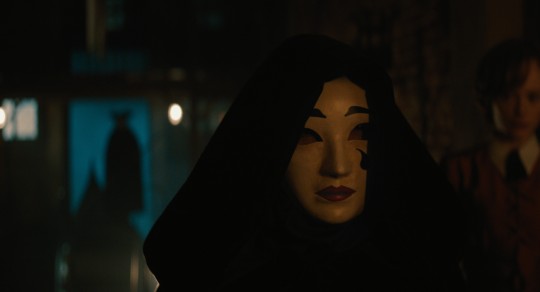
The weakest link here is Fey, who gives her role every bit as much cynic power as Branagh’s, but who is saddled with a character clearly meant to be a satirical tribute to Christie herself. She is said to have made Poirot famous by writing of his cases, and reminds us of this constantly, at one point even claiming Poirot is nothing without her stories. It’s an overbearing and obvious bit of meta-commentary, a tactic I’ve long grown tired of in fiction, and the character’s presence robs the film of that little touch it needed to be a mystery classic.
Even with that blemish, though, this is as close as Branagh’s ever come to capturing what he’s trying to do with these adaptations. I would like very much to see more. I’ve gotten what I’ve been looking for since 2017’s Murder on the Orient Express. I have faith in the series now.
Verdict: Highly Recommended
Note: I don’t use star ratings. Here are my possible verdicts:
Must-See
Highly Recommended
Recommended
Average
Not Recommended
Avoid Like the Plague
#kelly reilly#tina fey#kenneth branagh#a haunting in venice#disney#jamie dornan#michelle yeoh#horror#mystery#movies
6 notes
·
View notes
Text
Assassin's Creed Locations Ranked, Part 2
We're back with my second round of rankings for all of the explorable locations in the Assassin's Creed series. Just to reiterate: I included any region, including mythological ones, where free roaming and some degree of item collection was possible. This time, we visit a bunch more imaginary places within the imaginary settings, rank our first Ezio playgrounds, and pick on the locale of Valhalla's disappointing Dawn of Ragnarok DLC. Part one is here: https://ryanmeft.tumblr.com/post/728459520718831616/assassins-creed-locations-ranked-part-1 Let's get started.

28
Underworld (Odyssey: The Fate of Atlantis)
It’s to Ubisoft Quebec’s credit that they went out of their way to portray the bad mythological afterlives as thoroughly bad. The Greek underworld, or Hades, is a thoroughly benighted, fire-and-dust ravaged place ruled over by a cruel god and terrifying guardians. No one would ever want to step foot here, much less stay. And that’s the problem: Quebec did their work too well. Since you’re coming off the mountains and oceans of Greece and the idyllic paradise of Elysium, it doesn’t take long at all before you’re quite ready to move on from this place of torment. What you visit is far closer to the Christian Hell than any pagan concept, and about as enticing.
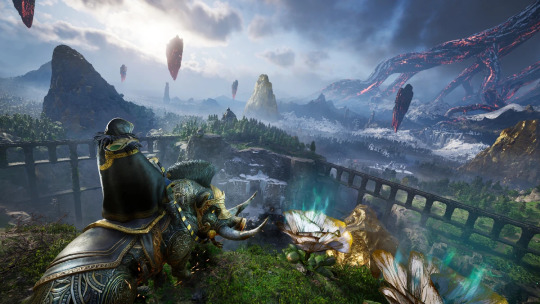
27
Svartálfaheimr (Valhalla: Dawn of Ragnarok)
Asgard, included in the base game as the setting of important story beats, was pretty fascinating. It not only had a variety of environments and some nice hints at the actual Isu civilization poking in here and there, but it used some of the most famous tales and characters of Norse Myth in ways that worked with Valhalla’s more self-interested tone. Fans had reason to think this surprise, late-life expansion would deliver more such adventures. It did not. It did almost nothing to tie the story or themes into the main setting, instead delivering a boring tale full of annoying dwarfs and an unlikable protagonist. Worse yet, it featured none of the creative environmental touches of Asgard, and very little involvement of that section’s supporting cast. Ubisoft asking $40 for this slog was insulting.

26
The SinaI (Origins: The Hidden Ones
Another DLC that promised the moon---the origin of the proto-Assassins---and turned in something far more pedestrian, this expansion’s lackluster treatment of the Sinai Peninsula matches the “it’s okay” vibe of the story as a whole. The Sinai looms large in Abrahamic religions, but what it amounts to in the game is a somewhat more vertical, rocky arm of Egypt. There aren’t even any references to the stories and legends that define the region. It’s kinda sad that Ubi had the chance to lean into the region’s storied history and dodged it.

25
Isle of Skye (Valhalla)
Did you forget this existed? That’s not surprising. It’s a technically Scottish offshoot of the main game’s England that is visited briefly, where you encounter a little reminder of Odyssey in a way the game mostly pulls off. Whereas England is mostly flat, muddy and rocky, Skye is more vertical, reminding players of the more varied and mountainous terrain of Odyssey. Your visit doesn’t last long enough to really register, but it’s a nice break from England.

24
Cappadocia (Revelations)
You visit this region of Turkey, famous for having underground cities, as a side hustle to your time in Constantinople. Unlike that city, it doesn’t feel like the developers just slapped a new coat of paint over Italy, and even lets you make your way into the upper reaches of the city’s cave. Unfortunately, you don’t get to leave that single area, and not letting you explore the unique geography of the region is a serious missed opportunity.

23
Thebes/The Valley of the Kings (Origins: Curse of the Pharaohs)
This one derives its place on the list almost entirely from allowing you to ramble about in the famous Valley of the Kings, the massive burial site of many well-known New Kingdom Pharaohs and the origin of the famous-but-false curse of Howard Carter. Sadly, you’re mostly passing through on the way to the various imaginary afterlife areas that make up the bulk of this DLC, and Thebes itself is no different elementally than the main game’s setting.
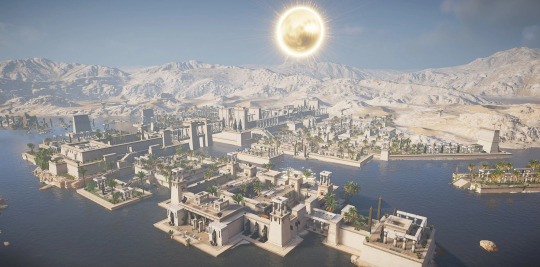
22
Aten (Origins: Curse of the Pharaohs)
Anybody interested in the famous stories of Akenhaten and his ill-fated attempt to replace Egyptian paganism with a proto-monotheism had to be really interested to see what kind of heaven such a person might create if they could. The answer? A fairly standard Egyptian city with a weird sun hovering over it. It’s the least impressive of COTP’s four mythological locations, but it still earns some points for trying to let us walk around in the psyche of one of the most famous failed rulers in history.

21
Duat (Origins: Curse of the Pharaohs)
Tutankhamen’s afterlife is neither an altered copy of the game’s main areas nor a twisted hellscape, but a shadowy place of wandering bathed in eternal evening hues and studded with strange purple plants. It’s not entirely dissimilar to Skyrim’s Blackreach, and if you could choose, there would be much worse places to spend eternity. It gets rather monotonous after a bit, since the scenery doesn’t change much as you wander, but you also won’t quite find yourself longing to leave for better places.

20
Monteriggioni (II)
I singled your base out from the wider Italy of Assassin’s Creed II because it plays such an important role in the story. Notably, the mysteries that imbue seemingly every corner of the structure and town fuel both the modern day story and Ezio’s connection to Altair. This was before the series started dropping in mysteries and connections to other entries like candy, so Altair’s notes and the shrine to past Assassins in the basement took on a much greater narrative heft than later buried secrets would. Most of the area is still pretty similar to the rest of Italy, so I can’t justify ranking it higher, but it remains the coolest base of operations in the series.
And that's it for this round. Next time: more myths, more Ezio, and of course a lot more Europe since Ubisoft is so terrified to go anywhere without white people.
1 note
·
View note
Text
Nintendo Games That Should be Re-Released, Part 1
Yesterday, Nintendo announced a smorgasbord of updated re-releases, including Paper Mario: The Thousand Year Door and Mario vs. Donkey Kong, as well as new info on that much-anticipated Super Mario RPG remake. Naturally, this has people talking about what other games Nintendo should re-release, but most of these people are wrong. They largely want their favorite games on the Switch, even if those games have already been re-released several times. What the fandom needs is more of what Nintendo announced in their direct: good games that no one remembers or has played in a long time because they're stuck on their original systems. These are those games.

Fire Emblem Awakening
Intended to be the final entry in the FE series due to slumping sales, Awakening’s relationship-based team building, more forgiving difficulty options and intriguing narrative instead revitalized the series from DOA to a real strategy contender. All the more a shame, then, that it remains stuck on the 3DS. A bit of a graphical upgrade and the DLC being included in the purchase price would make this classic worth revisiting on a modern system.
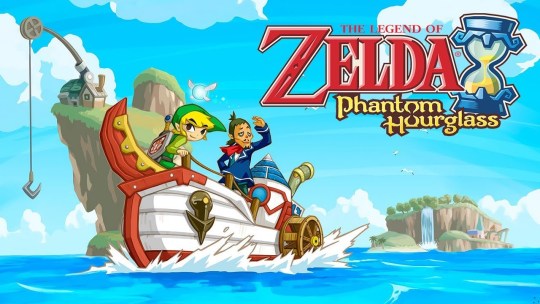
The Legend of Zelda: The Phantom Hourglass
Along with Zelda II and Spirit Tracks, this is generally regarded as one of the least essential Zelda games, but that doesn’t mean it doesn’t have plenty going for it. The problem with the original release is many people, even Zelda die-hards who bought it on the strength of the name, never saw most of it due to Nintendo’s frustrating insistence on pimping the DS’s touch screen for everything they could. A re-release that got rid of the mandatory touchscreen controls and maybe added a couple new whiz-bangs as a thank you would allow a lot more people to experience the game.

Donkey Kong Country Returns
Currently the only mainline DKC game that is not playable on any modern system, DKCR was a resounding critical and commercial success that not only re-galvanized the series after a long hiatus, but gave it a new direction just as compelling as the old one. The most updated way to play it is in a 3DS version, which is not the way to experience this game’s visual creativity. If Nintendo let it off the hook with new content similar to that in their Tropical Freeze re-release, we’d all go ape for it.
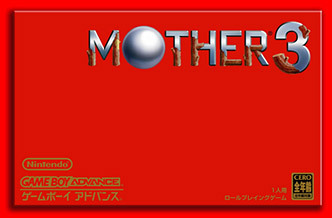
Mother 3
I’ll level with you: I tried the first Earthbound and couldn’t get into it at all. That said, I understood why the series was special back in the day, and why fans are understandably POed that Nintendo of Japan has been sitting on the third and final game for 17 years. Back in 2006, there was a logical business argument against releasing it in the west due to poor sales, shipping and packaging costs and localization, but digital delivery has lessened many of those obstacles, and after they did it with the first Fire Emblem, this would be a great show of support for the Big N’s loyal fans.

Wario Land Virtual Boy
Perhaps the biggest white whale in Nintendo history, the game was well-reviewed and even originated the idea of jumping between foreground and background, but the dismal failure of the Virtual Boy and the eye-splitting red and black visuals have relegated this to a game only the hardest of hardcore Nintendo fans have played. A bit more content to combat short length, a graphical overhaul to make it actually look good, and I’ll bet fans would snap this up.
That's it for part 1. Please like, share or comment, and I'll get the second part out as soon as I can.
1 note
·
View note
